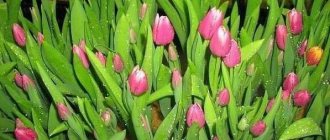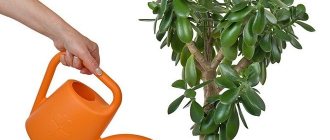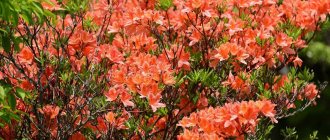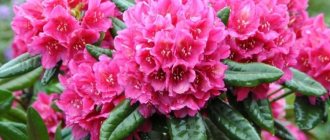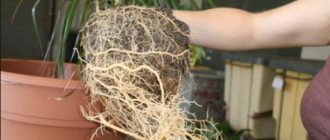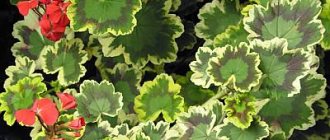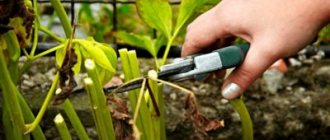Why is it necessary to fertilize rhododendron at home?
Over time, the plant takes all the nutrients from the soil. Depletion of the soil leads to yellowing and falling of leaves and lack of flowering. The effect of fertilizers is due to the fact that they supply the plant with the necessary chemical components that promote normal growth, and also saturate the soil with mineral and organic substances.
Azaleas grow and develop only in acidic soil with a pH of 4.0-5.0 .
If you deviate from this value, the roots of the plant cannot absorb nutrients, which means the bush stops growing and developing. Normal pH levels are also achieved by applying fertilizers. Azalea is valued for its decorative properties, and a deficiency of any nutrient worsens its condition and appearance. The problem of lack of flowering or changes in the appearance of leaves is also easily solved with timely and correct fertilizing.
The main feeding of the bush is designed to bring the acidity of the soil to the desired level and saturate the plant with nutrients that promote growth. Auxiliary feeding serves to support the plant during the growing season, budding and flowering.
Azaleas have a shallow root system, so to apply fertilizer it is necessary to use methods that exclude digging up the soil.
How to test soil acidity
If there are few flowers, there is no young growth, the leaves are pale, increasing the concentration or amount of fertilizing is unlikely to correct the situation. First of all, you need to check the acidity of the soil under the rhododendron. It must be within the pH range of 3.5-5.5, otherwise mycorrhiza does not work. Already with a neutral reaction, the symbiont mushrooms die, and without them the culture simply cannot absorb food.
To find out the exact numbers, you need to take soil samples to the laboratory. But the analysis is recommended to be carried out several times per season, and this is problematic. To independently determine acidity, it is enough to have litmus paper and an indicator scale:
- Several soil samples are taken in the tree trunk circle at a depth of 0 to 20 cm.
- The samples are mixed and filled with distilled water 1:4.
- Leave for 2 hours, shake occasionally.
- Check acidity using litmus paper.
Types of funds, their composition
Based on their origin, fertilizers are divided into the following.
Mineral
Simple
Increases the level of nitrogen (N), potassium (K) and phosphorus (P) in the soil:
- Nitrogen fertilizers promote the growth of branches and the development of foliage. The best choice for feeding azaleas would be Urea (carbamide). Contains 40-50% nitrogen, is highly soluble in water and contributes to soil acidification.
- Phosphorus fertilizers regulate plant metabolic processes and are a source of energy.
In acidic soil they become difficult for plants to reach, but do not affect the acidity of the soil. An effective supplier of phosphorus for azaleas is Phosphorite flour with a phosphorus content of 20-30%. When applied to the soil before planting and under the influence of soil acidity, it becomes accessible to azaleas and acts for several years. In the future, flour can be added to compost. - Potassium fertilizers increase resistance to diseases. Potassium sulfate contains 50% potassium and no chlorine, making it most suitable for azaleas. It is used both as a main and auxiliary fertilizer.
After flowering ends, nitrogen-containing fertilizers are applied; before buds appear and before flowering ends, fertilizers containing phosphorus and calcium are applied.
Complex
They are the most effective and easy to use, as they contain several nutrients. They are based on nitrogen, phosphorus and potassium compounds, magnesium salts, sulfur and a complex of trace elements. For example, Ammophos contains nitrogen and phosphorus, and Nitrophoska contains all three elements in correctly selected proportions.
Mineral fertilizers with a high content of sulfur and ammonium acidify the soil . Adding 30% ammonium sulfate to any complete mineral fertilizer forms an excellent fertilizer for azaleas. The preparation “Azalea” was specially developed as a ready-made complex fertilizer.
Do not use fertilizers containing chlorine!
Organic
- Cow dung .
0.5 kg must be filled with 5 liters of water and left for 3 days for fermentation. Then dilute 0.5 liters with 10 liters of water and water the plant. Pig and horse manure, as well as chicken manure, are not suitable for azaleas, as they increase the alkalinity of the soil. - Compost made from rotted grass and pine needles.
- Acidified water. Dissolve 1-2 tablespoons of citric acid in 10 liters of warm water. Use to increase acidity.
- Black tea . Its leaves contain calcium, magnesium, potassium, iron and other elements that help the development of the azalea's root system and promote its flowering. Pour 3 tablespoons of tea into 0.5 liters of boiling water. After cooling, drain. Dry the leaves and mix with soil when planting the plant (how to plant and replant an azalea?).
Before feeding the plant, it must be watered well.
Transplanting azalea
Transplanting azaleas should only be done when absolutely necessary. You can replant only once a year if the plant is not yet 3 years old, and twice a year if the plant is older. The reason for replanting an azalea can be a heavily overgrown root system that tightly envelops the substrate or rotting of the substrate with all sorts of formations on the surface. After purchasing an azalea in a store, try not to replant the flower for as long as possible. Give the flower time to adapt to new conditions.
When replanting azaleas, use special soil for rhododendrons.
Fertilizer application schedule in autumn, spring and other seasons
Indoor azaleas bloom in winter. It begins in November-January depending on the plant variety and lasts from 3 weeks to 2.5 months. To obtain a healthy plant and long flowering, you must adhere to the following feeding schedule:
- Spring – growth of green mass. Fertilizing with fertilizers containing nitrogen 2-4 times a month.
- Summer – saturation of the plant with phosphorus and potassium, organic fertilizers. Spraying with growth stimulants promotes the formation of a large number of buds. Frequency – 2-3 times a month.
- Autumn is the period of budding. Autumn feeding of rhododendrons is carried out 2-3 times a month with a complex with the addition of organic matter. Spray only on the leaves, avoiding contact with the buds (read about the rules for caring for rhododendron in the fall here).
- Winter is the flowering period. The azalea should be fed with complex fertilizers once a month. Do not spray.
We invite you to watch a video on how to properly fertilize azaleas in the spring:
Azalea lighting
Azaleas love bright light, other than direct sunlight. Direct sunlight can cause leaf burn in the form of dry tips. Shrubs of this type are more suitable for window sills facing the east, west and north. If you want to place the azalea on the windowsill of a south-facing window, cover it with a slightly matte sheet of plastic, thereby creating diffused light. In winter, azalea may suffer from lack of light. To increase daylight hours for azaleas, you can install additional lighting in the form of lamps with fluorescent lamps.
Features of feeding and care
Before the buds appear
- Particular attention should be paid to determining the acidity of the soil, bringing it to the required pH = 4.0-5.0. Use acidified water and add humus to the soil.
- To grow shoots and green mass, saturate the soil and plant with nitrogen.
- To prevent diseases, use Fitosporin according to the instructions (we talked in detail about the most common diseases and pests of azaleas in this article).
- During the budding period, add phosphorus and potassium to the nitrogen.
- Good results are obtained by fertilizing the plant with superphosphate at the rate of 15 g per 10 liters of water, as well as the preparations “Azalea”, “Kemira”, “Uniflon”.
During flowering
- Eliminate the supply of nitrogen.
- Do not spray plants.
- Continue saturating the azalea with phosphorus and potassium.
For the rhododendron to bloom
Growth stimulants, such as:
- "Zircon";
- "NV-101";
- "Ecogel-anti-stress";
- "Epin";
- succinic acid.
Spray the plants 2-4 times a month.
Read more about how to care for azaleas at home in a separate article.
From the history of azalea
Azalea was discovered in the late eighteenth and early nineteenth centuries in England. During his travels, the Dutch scientist Brainius discovered a plant that amazed him with its beauty; the bush strewn with fabulously beautiful flowers left him no choice. He brought it to his homeland, but after a short period the plant did not take root and died. Some time later, another traveler and scientist Conners attempted to tame the azalea, but also unsuccessfully; the bush could not withstand the move and also died.
Only at the very beginning of the nineteenth century did Captain Welbank bring from India the first specimen of azalea that managed to survive. After which this specimen became the ancestor of a great variety of hybrids and varieties. The work done by botanical scientists cannot be overestimated, because their long-term selection work contributed to the birth of this beautiful evergreen shrub, which pleases us with its lush flowering at a time when most plants are in a period of “hibernation”.
Step-by-step instructions for depositing funds
The fertilizer complex is designed for long-term action and fully provides the azalea with all the necessary components.
Pokon
Long lasting fertilizer. Developed specifically for rhododendrons and includes all essential nutrients and trace elements. Available in granule form.
Composition of the drug:
- nitrogen (N) -19%, phosphorus (P) -5%, potassium (K) -23%;
- magnesium (MgO)-2%;
- sulfur oxide (SO3) -12%.
Application : Scatter the granules around the plant in the spring or when planting and dig in carefully without damaging the roots. Consumption – 10-30 g per plant, depending on its size. It is necessary to regularly water the bush to gradually dissolve the fertilizer. The big advantage is that a single application to the soil provides nutrition to the plant for 6-7 months.
Bona Forte
Complex fertilizer in liquid form. Contains all the substances necessary for azaleas, providing nutrition and strengthening the immune system of the bush. The content of microelements in chelated form promotes their absorption in full.
Composition of the drug:
- nitrogen (N)-9%, phosphorus (P2O5)-5%, potassium (K2O)-6%;
- magnesium (MgO)-1%;
- trace elements: boron, iron, manganese, zinc, copper, molybdenum, cobalt;
- vitamins B1, PP, C;
- succinic acid.
Application: Using root fertilizers together with spraying the leaves gives the best results. For irrigation, dilute 10 ml of solution in 3 liters of water, for spraying - 5 ml per 3 liters.
Fertilizing indoor azaleas:
- March-October: 1 time per week.
- November-February: 1 time per month.
Feed transplanted plants no earlier than after 10-15 days!
Can manure be used?
When planting, mix 1 part of cow dung or humus with 10 parts of soil. In the process of the beginning of the formation of buds, carry out a second feeding with the addition of phosphorus-potassium fertilizer.
succinic acid
A product of amber processing is an organic growth stimulant. It cannot replace fertilizers, but its use reduces the risk of diseases, accelerates the development of azaleas, and prolongs flowering.
Application: dissolve 1 g of succinic acid in 10 liters of water. The solution can be used for watering and spraying plants no more than once every 3-4 weeks.
Errors and their consequences
Azalea does not tolerate an overdose of fertilizers, so it is necessary to strictly follow the instructions for using the drugs. Main mistakes and their consequences:
- If there is too much acid in the soil, the roots of the plant die.
- Oversaturation of a plant with nitrogen leads to abundant growth of green mass and lack of flowering.
- Spraying flowers leads to their death.
- Fertilizer containing chlorine will destroy the bush in a short time.
Rhododendron is a hybrid evergreen shrub. Another name is azalea. The plant is distinguished by its beauty and lush color. On our online portal you will find detailed instructions for caring for and replanting plants in the fall and after purchase, as well as learn about methods of propagation and pruning.
Preparations given at certain and correctly calculated periods make it possible to obtain a healthy plant with lush flowers.

